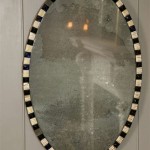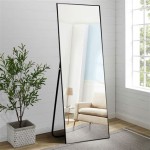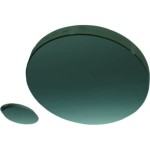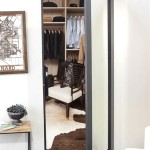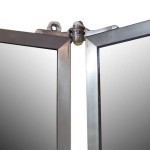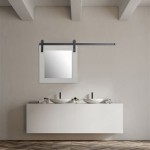Replacing a Bathroom Mirror: A Comprehensive Guide
Replacing a bathroom mirror can significantly update the look and feel of the space. Whether driven by aesthetic preferences, damage to the existing mirror, or a desire for increased functionality, this project can be tackled by most homeowners with basic DIY skills. This guide provides a step-by-step approach to replacing a bathroom mirror safely and effectively.
Assessing the Existing Mirror and Planning the Replacement
Before embarking on the replacement process, careful assessment and planning are essential. This includes considering the size and style of the new mirror, the mounting method, and the necessary tools and materials.
Key Considerations:
- Measure the dimensions of the existing mirror accurately.
- Determine the desired size and shape of the new mirror. Consider options like framed, frameless, or medicine cabinets.
- Evaluate the existing wall condition. Identify any damage or irregularities that may require repair before installation.
- Choose a mounting method. Options include adhesive, clips, or screws.
- Select the appropriate mirror mastic or adhesive based on the mirror's weight and the wall material.
Gathering Necessary Tools and Materials
Having the correct tools and materials readily available streamlines the replacement process and prevents unnecessary delays.
Essential Tools and Materials:
- Safety glasses and work gloves
- Putty knife or scraper
- Hammer
- Screwdriver (Phillips and flathead)
- Measuring tape
- Level
- Pencil
- Mirror mastic or adhesive
- Caulk gun (if using adhesive in a tube)
- Mirror clips or screws and anchors (depending on the chosen mounting method)
- Drop cloths or old towels
- Optional: Stud finder, masking tape
Removing the Old Mirror
Removing the old mirror requires caution and the proper technique to prevent injury and damage to the wall.
Steps for Removal:
- Cover the mirror surface with masking tape to prevent shattering and contain any broken pieces.
- If the mirror is glued to the wall, use a putty knife or thin wire to carefully separate the mirror from the adhesive. Work slowly and methodically to avoid cracking the mirror.
- If the mirror is held by clips, carefully unscrew or unclip them.
- If the mirror is attached with screws, remove them with a screwdriver.
- Once loosened, carefully lift the mirror off the wall. If it is large or heavy, enlist assistance.
- Clean the wall surface of any remaining adhesive or residue.
Preparing the Wall Surface
A properly prepared wall surface is crucial for secure and long-lasting mirror installation.
Wall Preparation Steps:
- Repair any damage to the wall, such as holes or cracks, with spackle or drywall compound. Allow to dry completely and sand smooth.
- Clean the wall surface with a damp cloth to remove dust and debris.
- Ensure the wall is dry before applying any adhesive or mounting hardware.
Installing the New Mirror
The installation process varies depending on the chosen mounting method. Adhering to the manufacturer's instructions for specific products is vital.
General Installation Steps:
- Mark the desired location of the mirror on the wall using a level and pencil.
- If using adhesive, apply it to the back of the mirror according to the manufacturer's instructions. Typically, adhesive is applied in vertical lines or dots.
- Carefully position the mirror on the wall, aligning it with the marked lines.
- Press firmly against the wall to ensure proper adhesion.
- If using clips or screws, install them according to the manufacturer's instructions. Ensure the mounting hardware is appropriate for the wall material and the weight of the mirror.
- If necessary, use shims to level the mirror.
Finishing Touches
Completing the installation with appropriate finishing touches enhances the overall appearance and provides a professional look.
Finishing Steps:
- If desired, apply a bead of sealant or caulk around the perimeter of the mirror to create a clean, finished edge and prevent moisture intrusion.
- Clean any excess adhesive or sealant with a damp cloth.
- Allow the adhesive or sealant to cure completely before using the mirror or cleaning the area extensively.
Safety Precautions
Safety should be a primary concern throughout the entire mirror replacement process. Taking appropriate precautions minimizes the risk of injury.
Safety Considerations:
- Always wear safety glasses and gloves when handling glass and sharp tools.
- Dispose of broken glass carefully in a designated container.
- Use appropriate lifting techniques when handling heavy mirrors. Enlist help if necessary.
- Follow manufacturer's instructions for all products and tools.
- Work in a well-ventilated area when using adhesives or sealants.

How To Professionally Install A Bathroom Mirror

How To Remove A Bathroom Mirror Lowe S

How To Safely And Easily Remove A Large Bathroom Builder Mirror From The Wall Site Title

How To Professionally Install A Bathroom Mirror
:strip_icc()/Design_CathieHongInteriorsPhoto_ChristyQPhotography-b2290decbe0e4d0b952f280fb7bdc896.jpg?strip=all)
How To Remove A Bathroom Mirror From The Wall

How To Professionally Install A Bathroom Mirror

How To Safely And Easily Remove A Large Bathroom Builder Mirror From The Wall Site Title

How To Frame Out That Builder Basic Bathroom Mirror For 20 Or Less

How To Professionally Install A Bathroom Mirror

10 Stunning Ways To Transform Your Bathroom Mirror


